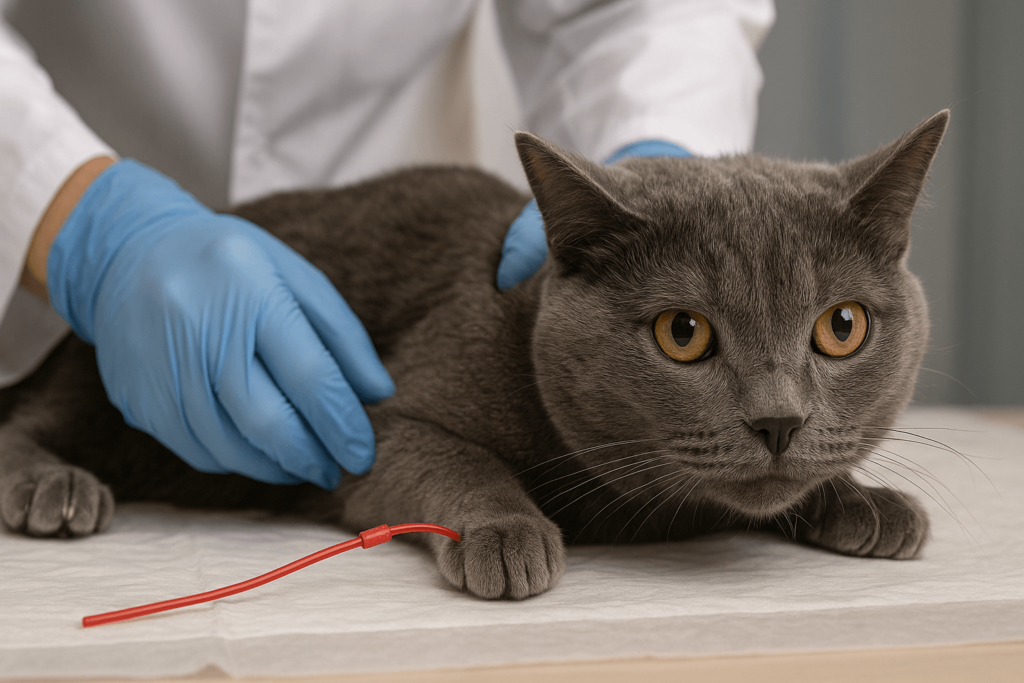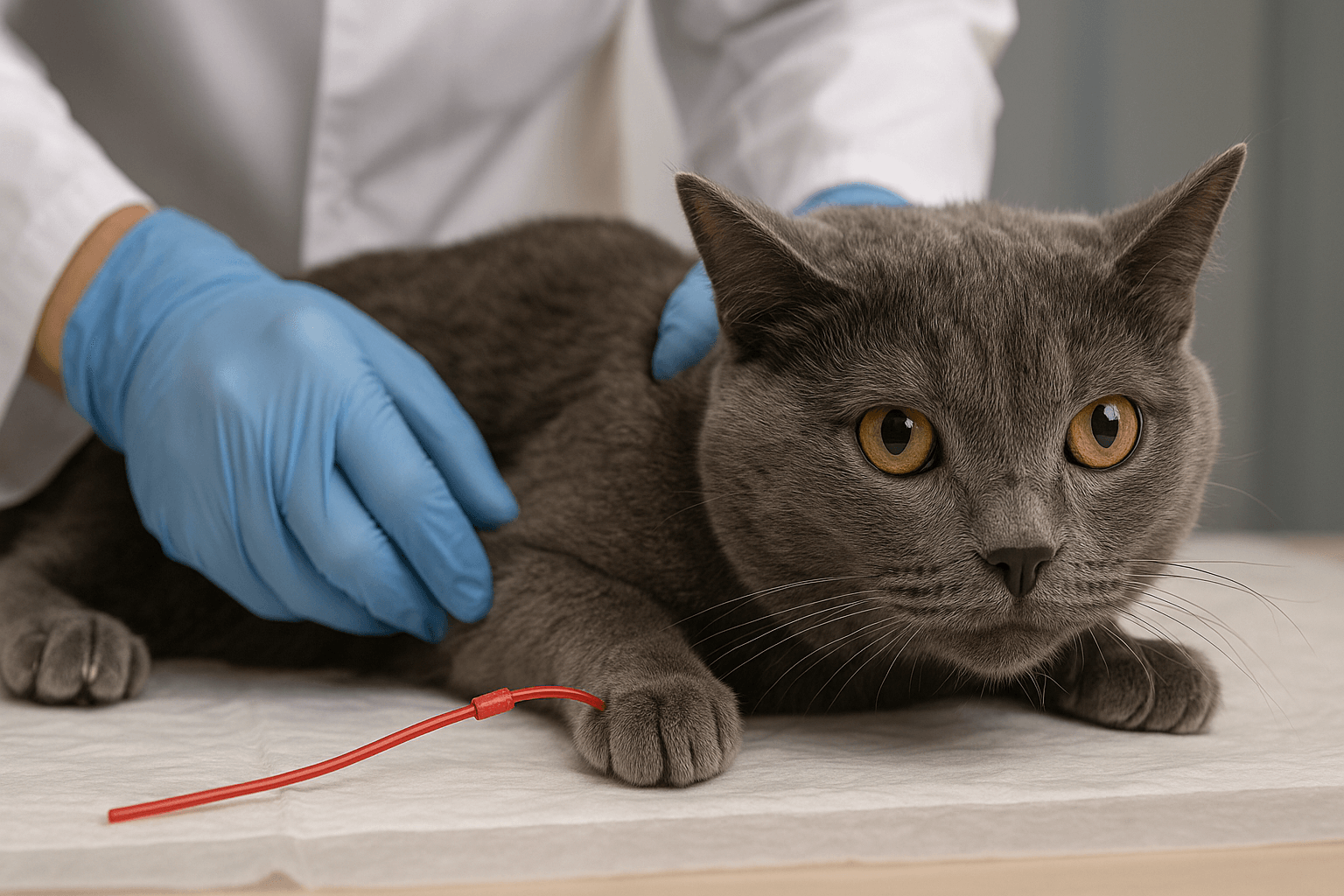Cat Urethral Obstruction: The Silent Emergency Every Owner Must Know
A cat stopped urinating isn’t just being stubborn—it’s in crisis. Cat urethral obstruction is a life-threatening emergency that can kill within 24 to 48 hours if untreated. It happens suddenly, often without warning, and affects male cats far more frequently due to their narrow urethras. Recognizing the signs early isn’t optional—it’s the difference between life and loss. This guide reveals everything you need to know: why it happens, how to spot it, what to do immediately, and how to prevent it from ever returning.
Why Cat Urethral Obstruction Is a Medical Emergency
Cat urethral obstruction isn’t a minor inconvenience—it’s a full-blown physiological collapse. When the urethra becomes blocked, toxins build up, kidneys shut down, and the bladder can rupture. Here’s what’s happening inside your cat’s body:
Toxin Buildup:
Urine backs up into the kidneys, flooding the bloodstream with waste products like creatinine and urea—leading to poisoning.Bladder Distension:
The bladder swells to dangerous sizes, stretching tissue to its limit and risking rupture or permanent nerve damage.Electrolyte Imbalance:
Potassium levels spike dangerously high (hyperkalemia), which can cause cardiac arrest—often without visible symptoms.Kidney Failure:
Without urine flow, filtration stops. Within hours, acute kidney injury begins, and recovery isn’t guaranteed.Shock and Collapse:
Pain, toxin overload, and heart strain combine to trigger systemic shock. Your cat may become lethargic, cold, or unresponsive.
This isn’t a “wait-and-see” situation. Every minute counts. If your cat is straining, vocalizing, or visiting the litter box with nothing to show for it—go to the vet now.

Common Causes of Urethral Obstruction in Cats
Obstruction rarely has one single cause. It’s usually a combination of anatomy, diet, stress, and environment. Understanding these triggers helps you reduce future risk.
Feline Lower Urinary Tract Disease (FLUTD):
A broad term for inflammation and crystal formation in the bladder and urethra—the most common precursor to blockage.Urinary Crystals or Stones:
Struvite or calcium oxalate crystals clump together, forming a plug that blocks the narrow male urethra.Mucous Plugs:
Inflamed bladder lining produces thick mucus that mixes with crystals to form a gel-like obstruction.Stress and Anxiety:
Changes in routine, new pets, loud noises, or even a dirty litter box can trigger inflammation and spasms in the urethra.Dehydration and Dry Food Diets:
Low water intake concentrates urine, increasing crystal formation and making blockages more likely.
Male cats are 10–20 times more at risk than females due to anatomy—but no cat is immune. Prevention starts with understanding the root causes—not just treating the symptoms.
Check this guide 👉Why Did My Cat Pee in My Suitcase? Best 7 Expert Tips!
Check this guide 👉Is Cat Pee Toxic? Best 7 Expert Tips!
Check this guide 👉Understanding Normal Cat Pee Clump Size: Best 7 Tips!
| Early Warning Signs | Advanced Emergency Signs |
|---|---|
| Frequent trips to the litter box with little or no urine | Crying out in pain while attempting to urinate |
| Licking the genital area excessively | Visible swelling or distension of the lower abdomen |
| Small amounts of bloody or cloudy urine | Lethargy, weakness, or inability to stand |
| Avoiding the litter box or urinating outside it | Vomiting, nausea, or refusal to eat |
| Hiding more than usual or appearing anxious | Cold paws, pale gums, or rapid, shallow breathing |
What Happens at the Vet During Treatment
Time is critical. If you suspect obstruction, immediate veterinary care is non-negotiable. Here’s what to expect when you arrive:
Physical Examination:
The vet will feel your cat’s abdomen—distended, firm, and painful? That’s a clear sign of urinary retention.Bloodwork and Urinalysis:
Tests check for elevated kidney values, potassium levels, and signs of infection or crystals.Catheterization:
A thin tube is carefully inserted into the urethra to drain the bladder and flush out the blockage.Fluid Therapy:
IV fluids correct dehydration, flush toxins, and stabilize electrolytes—often for 24–72 hours.Pain Management and Monitoring:
Medications control pain, reduce spasms, and support kidney function. Your cat may stay hospitalized for observation.
The procedure is urgent, not elective. Delaying treatment increases the risk of permanent kidney damage or death—even if your cat seems “a little better” after a few hours.
Risk Factors: Who Is Most Likely to Be Affected?
Not all cats are equally at risk. Certain factors dramatically increase the chance of obstruction—and knowing them helps you prioritize prevention.
Male Cats:
Especially neutered males under 10 years old—their narrow, S-shaped urethra is prone to blockage.Indoor-Only Cats:
Lack of environmental stimulation increases stress and reduces movement, contributing to FLUTD.Cats on Dry Food Diets:
Low moisture intake leads to concentrated urine, a breeding ground for crystals and mucus.Overweight or Sedentary Cats:
Obesity reduces mobility and increases inflammation, making urinary issues more likely.Cats in Multi-Pet Households:
Competition for resources, territorial tension, or inconsistent routines trigger chronic stress.
If your cat fits even two of these categories, you’re in the high-risk zone. Prevention isn’t optional—it’s essential.
How to Prevent Recurrence After Treatment
A cat that’s had one blockage has a 50% chance of having another within a year. But recurrence is not inevitable. Here’s how to break the cycle:
Switch to Wet Food Exclusively:
High moisture content dilutes urine and reduces crystal formation. Aim for 100% wet food unless advised otherwise.Increase Water Intake:
Use cat fountains, multiple water bowls, or add water to wet food. Some cats prefer running water.Reduce Environmental Stress:
Provide vertical space, hiding spots, consistent routines, and avoid sudden changes. Use pheromone diffusers like Feliway.Maintain a Healthy Weight:
Work with your vet on a weight loss plan if needed. Even 1–2 pounds makes a difference.Schedule Regular Vet Checkups:
Urinalysis every 6–12 months can catch early inflammation before it becomes life-threatening.
Prevention is cheaper, less traumatic, and far more effective than emergency surgery. Make it part of your cat’s daily care.
Myths About Cat Urethral Obstruction—Debunked
Misinformation costs lives. Don’t let these dangerous myths delay your response.
Myth: “He’ll go on his own after a while.”
False. The blockage won’t resolve without medical intervention. Waiting leads to organ failure.Myth: “Only older cats get blocked.”
No. Young, healthy male cats are most at risk—often between 1 and 6 years old.Myth: “Dry food is fine if it’s ‘premium.’”
Premium doesn’t mean high-moisture. Even expensive kibble lacks the water cats need.Myth: “If he’s eating, he’s okay.”
Many cats eat normally until the very end. Appetite is not a reliable indicator of urinary health.Myth: “I can treat this at home with home remedies.”
There are no safe home cures. Delaying vet care = risking death.
Trust science, not anecdotes. Your cat’s life depends on it.
When to Call the Vet—Even If You’re Not Sure
If you hesitate, you risk losing your cat. Here’s your action checklist:
- Straining in the litter box for more than 10 minutes with no urine? → Call immediately.
- Found urine outside the box with blood or strong odor? → Call immediately.
- Cat is lethargic, hiding, or vocalizing abnormally? → Call immediately.
- Saw your cat lick genitals obsessively? → Call immediately.
- Just have a gut feeling something’s wrong? → Call immediately.
There is no such thing as “maybe.” If you suspect obstruction, treat it as an emergency—because it is.
FAQ: Cat Urethral Obstruction
Can female cats get urethral obstructions?
Rarely. Their wider urethra makes blockage unlikely, but they can still develop FLUTD and bladder inflammation.
Is cat urethral obstruction contagious?
No. It’s not infectious. But multiple cats in the same household may develop it due to shared stressors or diets.
How long can a cat survive with a blocked urethra?
Up to 48 hours, but serious damage begins within 12–24 hours. Survival drops sharply after 36 hours without treatment.
Can I use a catheter at home?
Absolutely not. Catheterization requires anesthesia, sterile technique, and professional training. Attempting it can kill your cat.
Will my cat always be at risk after one episode?
Yes. Recurrence is common. Long-term management with diet, hydration, and stress reduction is essential.
Protect What You Love—Before It’s Too Late
Cat urethral obstruction doesn’t announce itself with drama. It creeps in quietly—a missed litter box, a tired glance, a small change in behavior. By the time the signs are obvious, it’s already critical. But you have power. You have knowledge. You have the ability to act before it’s too late.
Feed wet food. Fill the fountain. Reduce stress. Watch closely. Trust your instincts.
Canned Pumpkin for Cat Diarrhea: Best 7 Expert Tips! Natural remedy to firm stools, soothe upset bellies, and support gut health safely.
Can a Cat Give You Scabies? Best 7 Expert Tips! Discover the truth about feline mites, human skin risks, and how to protect yourself—without panic.
Cat Flea vs Human Flea: Best 7 Expert Tips! Discover the truth about bites, species, and how to eliminate infestations for good.
Weird Cat Behaviors: Best 7 Expert Tips! Discover why cats do strange things—and how to understand, not punish, their instincts for a happier home.





